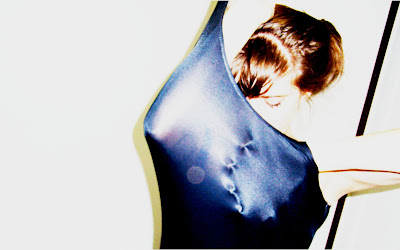
A swimsuit, bathing suit, togs or swimming costume is an item of clothing that is tight-fitted and designed to be worn while participating in water sports of leisure activities. For women, the swimsuit is either a two-piece top and bottom ensemble or a one-piece maillot style. The first swimsuits concealed most of the body, women wore bloomers, black stockings, and a dress with short sleeves or shirt. Today women's 'bathers' are generally bikinis, one-piece variations or thongs, with the intension to reveal as much as the body as possible without actual nudity.
The concept of developing my own design approach for experimentation with the swim suit seemed challenging. I was drawn to follow up on my recently explored performance enhancing fabrics, as I found that this could become a strong approach for this weeks exercise. Unlike regular swimsuits, which are designed mainly for the physical appearances, competitive swimwear is manufactured for the purpose of aiding athletes, increasing their efficiency . Parallel to this is the utilization of wetsuits produced from foamed neoprene that insulate the wearer and provide them with buoyancy in the sometimes harsh sea conditions.
With all this in mind I had the idea to incorporate neoprene into my design, but not as proficiently as it is intended for. The type of design I want to form may not be wearable for water purposes or even practical. This 'Avant-Garde' approach is something that I want to explore in the next project, especially as I will be carrying out the construction of the experimental swimsuit from week 7 onwards. It will assist me in launching into a new design direction as the foundation can be extended further than one weeks work, giving me strong support to initiate more toile's from.
Russh Magazine Issue 32- Swimwear Shoot (January. February 2010)



This album of images featured in this Russh photo shoot merges athleticism and femininity together to form a powerful compilation of swim and sports wear that has inspired me to
After speaking to my friend grace in 3rd year about my project direction, she guided me to a designer called Lisa Marie Fernandez. Once I had viewed her recent collection it was evident that it related to my design direction, with its blocked colours and of course fabrication. As a designer reference she follows the same fundamentals that I am wanting to attain in the way she uses an innovative fabric that is made to perform, molding the body's form whether creating curves or supporting them.

'The collection takes its cues from the bold, colour-blocked suits of the eighties but the look is totally modern. with their chunky zips and taut silhouette, there's a strong sexiness to them thats bonafide Bond girl. But the clean design of the various styles subtly adapted to each wearer's individual aesthetic, from the sunbather to surfer. LMF bikinis can be directional, sporty, sophisticated and glamorous. The modular collection has various colours and styles that are made to endlessly coordinate.'
(above image http://www.lisamariefernandez.com/main.html viewed 2/4/10)















